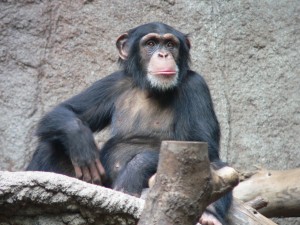
Although their behaviour may not equate with some of the clichéd lifestyle changes associated with human midlife crises, a paper published recently in the Proceedings of the National Academy of Sciences suggests emotional highs and lows may also be an inherent characteristic in chimpanzees and orang-utans.
An international team that included scientists, zookeepers, and wildlife carers from the United States, Germany, Japan, Canada, Australia, Singapore, and the UK, used a four-item questionnaire, based on human subjective wellbeing measures but modified for use in non-human primates, to assess the level of contentment in 508 animals across a broad age range, and split into three groups. It was a decision made in a “burst of madness, since no study had ever been attempted,” according to economist Andrew Oswald from the UK’s University of Warwick, and a co-author of the report. He said the team was “just stunned” when results indicated the primates from all three groups showed evidence of experiencing a slump in wellbeing during their middle years.
The questions included measuring each animal’s moods, their enjoyment of social interaction, and success at achieving goals.
Co-author Alex Weiss from the University of Edinburgh’s School of Philosophy, Psychology and Language Science, said it was commonly understood that dips in wellbeing occur in middle age, and documented evidence for this can be found in many human cultures, although he conceded great apes are not known for their pursuit of radical or risky lifestyle changes during middle age, as humans can be.
“We took a step back and asked whether it’s possible that instead of the midlife crisis being human-specific, and driven only by social factors, it reflects some evolved tendency for middle-aged individuals to have lower wellbeing. In all three groups we found evidence that wellbeing is lowest in chimpanzees and orang-utans at an age that roughly corresponds to midlife in humans. On average, wellbeing scores are lowest when animals are around 30 years old,” Weiss said.
The results showed that the U-shaped pattern or “midlife crisis” emerged with or without the use of parametric methods, implying that human wellbeing’s curved shape is not uniquely human and that, although it may be partly explained by aspects of human life and society, its origins may lie partly in the biology humans share with great apes. The findings have implications across scientific and social-scientific disciplines, and may help to identify ways of enhancing human and ape wellbeing.
“It’s as though the U-shape is deep in the biology of humans, and could be something human-like that we share with our social cousins,” Oswald said. “But our result does seem to push away the likelihood that it’s dominantly something to do with human life. Maybe nature doesn’t want us to be contented in middle age. Maybe discontent lights a fire under people, causing them to achieve more for themselves and their family,” he said.
Weiss believes the research provides opportunities for a deeper understanding of the emotional turmoil experienced by some men.
“If we want to find the answer as to what’s going on with the midlife crisis, we should look at what is similar in middle-aged humans, chimps and orang-utans.”
Anne Layton-Bennett
Reference:
The article “Evidence for a midlife crisis in great apes consistent with the U-shape in human well-being” was published by Proceedings of the National Academy of Sciences in December 2012: Vol. 109, No. 49 p19949-19952 http://www.pnas.org/content/109/49/19949.full?sid=becb7b95-8a4f-4198-ac43-005815ff63eb

